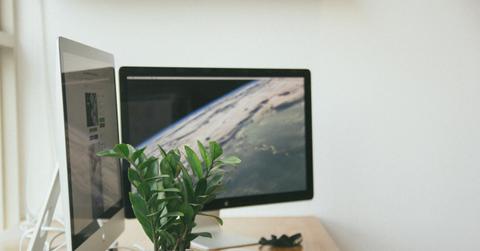The Millennial Freelancer’s Guide To Going Green
A five-part guide to making your home working environment eco-friendly without giving up on the perks of that glorious freelance life.
Updated Nov. 19 2020, 9:41 p.m. ET
Being a freelancer has many benefits. When you work for yourself, you have the opportunity to manage your own schedule, freely organize your workspace, and finally have full control over the (at-home) office thermostat.
But while working from home inevitably means curbing carbon emissions by minimizing your wardrobe and negating your daily commute, there are plenty of other places where bad eco habits can rear their dirty heads. Here are five smart-yet-simple ways you can make your home working environment environmentally sustainable.
Choose your office supplies wisely.
When you’re used to working in a company office, it can be easy to take advantage of the seemingly endless supply of stationary. You don’t realize how much you waste (and how little equipment you actually need) until you go freelance and it becomes your responsibility to stock up. Only then — when you’re trying not to go broke on office supplies — do you realize how much waste there really is in offices. In fact, data suggests that the average office worker tears through 10,000 sheets of paper every year. Yikes.
The rise of the digital market allows remote work to flow mostly through online channels. But at some point, you’ll inevitably have to resort to physical paperwork, whether for filing and posting documents or jotting down notes while you’re on a conference call. In this case, consider purchasing stationery made from reused materials. Think notebooks made from recycled paper (or notebook sleeves for you to fill), bamboo desk tidies, and refillable pens.
You might even want to consider the way in which you store and file your papers. Try replacing plastic sleeves with paper folders — when they become worn, you can just recycle them again!
Ration your utilities.
Working from home can be expensive, especially when you’re using up gas and electricity for domestic and work use. Take a look at your personal habits. Do you ever take a 20-minute TV break away from your laptop? Do you work all day under artificial light? Rely on a furnace, air conditioning, or central air for climate control?
Consider using your breaks for brisk walks around the block. Open the curtains for natural light (or better yet, work outside!). And throw open a window or two before turning to central air.
Do you ever get so caught up in working that you leave your cup of coffee to go cold, only to have to warm it back up again? In addition to choosing coffee grown sustainably, be sure to make eco-friendly choices when it comes to the appliances you’ll use to brew said coffee. There are a range of eco kettles to choose from, some of which act like a thermal flask in order to save the wasted electricity of having to reboil water. With some kettles, you can even choose how much water you want to boil by the cupful, so that you’re never using more water than you actually need.
Those days when you’re working away from home or commuting to meetings, be sure to have a thermal, reusable cup (and sleeve) to take with you. It’ll save you from spending money on a plastic cup of coffee when you’re out and about.
Invest in innovative technology.
Keeping your devices plugged in and continuously charging might seem practical if you’re doing most of your work on laptops and monitors, but it’s neither environmentally friendly nor cost-effective. As it turns out, a full 70 percent of U.S. energy production is wasted as heat emitted by electronics like laptops or phone during use.
You can improve your gadget use by only charging devices when you actually need to charge them, but there’s also an ethical approach you can adopt when purchasing technology. Consider investing in solar chargers, which rely on the sun to power up your tech. And don’t forget that after you’ve stocked up on your new gadgets, you can recycle old chargers and devices that you no longer need.
It’s not just about the equipment you use for work, either — going green has to do with the conditions under which you are working, too. Consider swapping your home lights for LED bulbs so you can clearly see what you’re working on while sucking less power from the grid.
Green your work space with some actual greenery.
Around 4.3 million people die every year from exposure to household air pollution, according to the World Health Organization. One very easy way to filter the air at home? House plants.
From ferns to anthuriums, indoor plants can be extremely low-maintenance while livening up a home office space and purifying the air around you. Good-looking and effective at reducing harmful volatile organic components? Yes please. Visit your nearest gardening center to find out the best type of plants to suit your indoor workspace.
Think green when it does come time to commute.
As comfortable as you may get working from home, there will come a time when you have to step back into the outside world for a contract gig, meeting, project, or networking event. When that times comes, consider your impact while traveling. Wherever possible, walk, bike, or use public transit.
Keep in mind that it’s the small changes to old habits that can make the big differences. As you begin to adapt your freelance work culture to become more environmentally friendly, it will be easier to sustain a healthier, greener lifestyle and you’ll find yourself making smarter choices.
